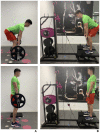Comparison of Electromyographic Activity During Hip Extension Exercises Under Gravitational or Inertial Loading Conditions
- PMID: 33906543
- PMCID: PMC8883425
- DOI: 10.1177/19417381211011407
Comparison of Electromyographic Activity During Hip Extension Exercises Under Gravitational or Inertial Loading Conditions
Abstract
Background: Hamstring injury prevention programs include strengthening, especially eccentric exercises using both gravitational and inertial loading. Inertial exercises are characterized by eccentric contractions of high intensity and velocity. This study aimed to analyze the muscular activation of the biceps femoris (BF), semitendinosus (ST), gluteus maximus (GM), and gracilis (GC) muscles during hip extension (HE) exercises performed under both gravitational and inertial loading conditions.
Hypothesis: Inertial training would generate a greater activation of HE muscles than gravitational training.
Study design: Cross-sectional study.
Level of evidence: Level 4.
Methods: Fifteen resistance-trained men performed the unilateral straight knee bridge (SKB), 45° of HE, and stiff-leg deadlift (SDL) exercises under gravitational and inertial loading conditions. Concentric and eccentric phases were identified with a linear encoder. Differences between load types, exercises, and their interaction were examined to establish the electromyographic (EMG) activity of each muscle and BF/ST ratio.
Results: In the concentric phase, inertial loading showed a higher normalized EMG than gravitational loading for BF, ST, and GM. SKB and HE activated BF and ST between 9.6% and 24.3% more than SDL. In the eccentric phase, the inertial modality achieved greater GM activation than the gravitational form (18.1%). BF activation was increased with HE and SKB as compared with SDL (24.4% and 16.4%, respectively), while ST activation was likewise enhanced with HE as compared with SDL (15.1%).
Conclusion: Inertial training is more effective than gravitational training for the concentric activation of the hamstring muscles while SDL showed lower hamstring activation than HE and SKB. Therefore, HE and SKB with inertial loading should be taken into account in hamstring training programs.
Clinical relevance: Inertial training is more effective than gravitational training for the concentric activation of the hamstring muscles. HE and SKB with inertial loading should be taken into account in hamstring training programs.
Keywords: iso-inertial; muscle power; physiology; resistance training.
Conflict of interest statement
The authors report no potential conflicts of interest in the development and publication of this article.
Figures




Similar articles
-
Muscle Activation Differences During Eccentric Hamstring Exercises.Sports Health. 2021 Mar;13(2):181-186. doi: 10.1177/1941738120938649. Epub 2020 Aug 28. Sports Health. 2021. PMID: 32857686 Free PMC article.
-
Validity of an inertial system for measuring velocity, force, and power during hamstring exercises performed on a flywheel resistance training device.PeerJ. 2020 Oct 9;8:e10169. doi: 10.7717/peerj.10169. eCollection 2020. PeerJ. 2020. PMID: 33083155 Free PMC article.
-
High-density electromyography activity in various hamstring exercises.Scand J Med Sci Sports. 2019 Jan;29(1):34-43. doi: 10.1111/sms.13303. Epub 2018 Oct 4. Scand J Med Sci Sports. 2019. PMID: 30230042
-
Electromyographic activity in deadlift exercise and its variants. A systematic review.PLoS One. 2020 Feb 27;15(2):e0229507. doi: 10.1371/journal.pone.0229507. eCollection 2020. PLoS One. 2020. PMID: 32107499 Free PMC article.
-
An Evidence-Based Framework for Strengthening Exercises to Prevent Hamstring Injury.Sports Med. 2018 Feb;48(2):251-267. doi: 10.1007/s40279-017-0796-x. Sports Med. 2018. PMID: 29116573 Review.
Cited by
-
Differences in lower limb muscle activation between global and selective instability devices in single-leg stance in healthy active subjects.PeerJ. 2022 Apr 18;10:e13317. doi: 10.7717/peerj.13317. eCollection 2022. PeerJ. 2022. PMID: 35462768 Free PMC article.
References
-
- Andersen V, Fimland MS, Mo DA, et al.. Electromyographic comparison of barbell deadlift, hex bar deadlift, and hip thrust exercises: a cross-over study. J Strength Cond Res. 2018;32:587-593. - PubMed
-
- Askling C, Karlsson J, Thorstensson A. Hamstring injury occurrence in elite soccer players after preseason strength training with eccentric overload. Scand J Med Sci Sports. 2003;13:244-250. - PubMed
-
- Bourne MN, Duhig SJ, Timmins RG, et al.. Impact of the Nordic hamstring and hip extension exercises on hamstring architecture and morphology: implications for injury prevention. Br J Sports Med. 2017;51:469-477. - PubMed
-
- Bourne MN, Opar DA, Williams MD, Najjar AA, Shield AJ. Muscle activation patterns in the Nordic hamstring exercise: impact of prior strain injury. Scand J Med Sci Sports. 2016;26:666-674. - PubMed
MeSH terms
LinkOut - more resources
Full Text Sources
Other Literature Sources
Research Materials
Miscellaneous

